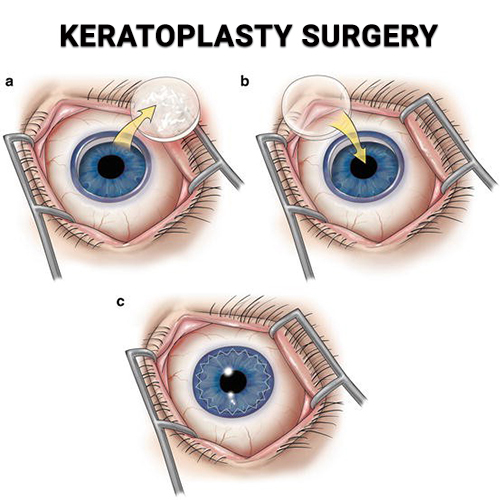 (212) 861-9797
(212) 861-9797
 (212) 861-9797
(212) 861-9797
A keratoplasty is the medical term for a cornea transplant. If the cornea in one of both of your eyes becomes damaged or diseased, the disabled cornea degrades your vision. Losing your sight is a traumatic experience, but one that can be solved in this case. Well known as eye care experts and the best retina doctors & ophthalmologists at Vitreous Retina Macula Consultants of New York perform the most appropriate of several keratoplasty surgery procedures to replace your cornea with donor or artificial tissue. To find out if you’re a good candidate for keratoplasty surgery, call the nearest offices of VRMNY to schedule a consultation.
Keratoplasty describes a surgical procedure to replace your eye’s damaged or diseased cornea with donated corneal tissue. Your cornea is the clear, dome-shaped layer of tissue at the very front of your eye. Light enters your eye through the cornea, so when it’s damaged, your eyesight suffers.

After a cornea transplant, you can expect improved vision and reduced pain. While all surgical procedures carry minimal risk, keratoplasty surgery is safe and effective. You reduce the risks even more by relying on the experienced and well-reviewed ophthalmologists at Vitreous Retina Macula Consultants of New York (VRMNY). These award-winning eye doctors have done groundbreaking research, developed new techniques and published peer-reviewed articles in the nation’s top medical journals.
Eye doctors usually recommend keratoplasty when cornea damage ruins your vision. Your cornea helps focus light rays onto your retina, which is the light-sensitive area at the back of your eye. The retina sends images to your brain through your optic nerve. But the process begins with the light that enters your eye through the cornea.
While poor vision is the most common reason for keratoplasty, your ophthalmologist may also recommend a corneal transplant for other reasons, such as to address:
Considering the importance of vision and the numerous serious diseases which pose a life changing threat, there is no room for error. The finest eye specialists in the country are found at VRMCNY. I have been a patient there for decades and have been seen by several doctors. They define the meaning of expert and consult with one another to ensure accuracy. The office is spotless. The staff is courteous and professional. The visits are usually time consuming due to the necessity of imaging and a preliminary exam with a technician before seeing the specialist. I consider myself fortunate and am very grateful to be a patient there.
Keratoplasty is an umbrella term for several different specialized cornea-related procedures. Your actual procedure depends on whether your eye doctor decides to remove the entire thickness or just a section of your cornea that’s diseased or damaged. It all depends on your cornea’s condition and the diagnosis. Your VRMNY ophthalmologist may choose a technique from many possibilities, including:
VRMNY has some of the nation’s top ophthalmologists, so you can trust that you’ll get the right corneal transplant for your needs. When you meet with your doctor for an initial consultation, you spend part of the time confirming which procedure would best help you.
Before the surgery, your doctor administers either a local or general anesthetic, depending on the procedure chosen. Most often, all you need is some local anesthesia. It’s a painless experience performed in the VRMNY offices in Manhattan, Brooklyn or Westchester. The length of time your eye surgeon needs depends on the complexity of the procedure.
After your doctor has completed the procedure, you may rest for a while before being released. You need to arrange for a ride home, as you’re encouraged not to drive yourself. You’re given a set of instructions to promote healing and recovery that usually include:
Keratoplasty usually restores your vision, and any surgical complications are rare and minor. Choosing the top-rated ophthalmologists at VRMNY for your procedure increases your chance of success and reduces the possibility of any problems. Contact the eye specialists today to schedule your initial consultation.
Let us help you enjoy your life
Call: (212) 861-9797To Speak With An Appointment Coordinator Now